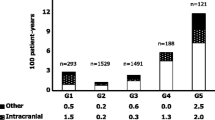Abstract
Background
The post-marketing surveillance of edaravone has reported serious adverse reactions, including renal and hepatic disorders. Renal disorders were the most frequently reported serious/important adverse reactions, which led to the evaluation of their causation by edaravone, their severity, and the recovery of renal function.
Methods
A retrospective review was carried out of 207 Japanese patients with acute stroke who developed renal disorders on edaravone treatment.
Results
No particular factor other than edaravone was found as a possible cause of the renal disorders in 17 patients (8.2%). In 91.8% of the patients evaluated, factors other than edaravone were associated with the development of renal disorders. Severe deterioration of systemic status (e.g., a severe infection or a decrease in blood pressure) was considered to be a highly probable cause of renal disorders that occurred before or during treatment with edaravone in 135 patients (65.2%). Fifty-nine patients (28.5%) underwent blood purification treatment (BPT). In the remaining 148 patients without BPT, the peak serum creatinine (SCr) level during follow-up was 3 mg/dl or more in 93 patients (44.9%) and less than 3 mg/dl in 55 patients (26.6%). The severity of renal disorders was moderate to severe in 73.3% of the 207 patients, and renal function recovered in 43%.
Conclusions
Appropriate treatment of deteriorated systemic status and the discontinuation of edaravone administration following the early discovery of renal disorders are recommended to reduce the development of severe renal disorders during edaravone treatment. The precise role(s) of edaravone in the pathogenesis of renal disorders should be evaluated in the future.
Similar content being viewed by others
References
Y Yamamoto T Kuwahara K Watanabe K Watanabe (1996) ArticleTitleAntioxidant activity of 3-methyl-1-phenyl-2-pyrazolin-5-one Redox Rep 2 333–8 Occurrence Handle1:CAS:528:DyaK2sXjsl2qtg%3D%3D Occurrence Handle10.1080/13510002.1996.11747069 Occurrence Handle27406414
A Mizuno K Umemura M Nakashima (1998) ArticleTitleInhibitory effect of MCI-186, a free radical scavenger, on cerebral ischemia following rat middle cerebral artery occlusion Gen Pharmacol 30 575–8 Occurrence Handle1:CAS:528:DyaK1cXhs12gsrc%3D Occurrence Handle10.1016/S0306-3623(97)00311-X Occurrence Handle9522178
K Abe S Yuki K Kogure (1988) ArticleTitleStrong attenuation of ischemic and postischemic brain edema in rats by a novel free radical scavenger Stroke 19 480–5 Occurrence Handle1:CAS:528:DyaL1cXks1Kksr0%3D Occurrence Handle10.1161/01.STR.19.4.480 Occurrence Handle2834836
K Houkin N Nakayama K Kamada T Noujou H Abe T Kashiwaba (1998) ArticleTitleNeuroprotective effect of the free radical scavenger mci-186 in patients with cerebral infarction: clinical evaluation using magnetic resonance imaging and spectroscopy J Stroke Cerebrovasc Dis 7 315–22 Occurrence Handle1:STN:280:DC%2BD2srntlGktw%3D%3D Occurrence Handle10.1016/S1052-3057(98)80049-9 Occurrence Handle17895107
InstitutionalAuthorNameEdaravone Acute Infarction Study Group (2003) ArticleTitleEffect of a novel free radical scavenger, edaravone (MCI-186), on acute brain infarction. Randomized, placebo-controlled, double-blind study at multicenters Cerebrovasc Dis 15 222–9 Occurrence Handle10.1159/000069318
K Kimura S Kazui K Minematsu T Yamaguchi (2004) ArticleTitleHospital-based prospective registration of acute ischemic stroke and transient ischemic attack in Japan J Stroke Cerebrovasc Dis 13 1–11 Occurrence Handle10.1016/j.jstrokecerebrovasdis.2003.11.025 Occurrence Handle17903943
Wasaki M. Effects of intravenous administration of MCI-186 on renal blood flow in rats (company data of Mitsubishi Pharma Corporation, Osaka 2004 (in Japanese)
H Yoshida K Sasaki Y Namiki N Sato N Tada (2005) ArticleTitleEdaravone, a novel radical scavenger, inhibits oxidative modification of low-density lipoprotein (LDL) and reverses oxidized LDL-mediated reduction in the expression of endothelial nitric oxide synthase Atherosclerosis 179 97–102 Occurrence Handle1:CAS:528:DC%2BD2MXhtlOmtbc%3D Occurrence Handle10.1016/j.atherosclerosis.2004.10.037 Occurrence Handle15721014
T Yamashita M Shoge E Oda Y Yamamoto JC Giddings S Kashiwagi et al. (2006) ArticleTitleThe free-radical scavenger, edaravone, augments NO release from vascular cells and platelets after laser-induced, acute endothelial injury in vivo Platelets 17 201–6 Occurrence Handle1:CAS:528:DC%2BD28Xms1aju7k%3D Occurrence Handle10.1080/09537100500444063 Occurrence Handle16702048
Author information
Authors and Affiliations
Corresponding author
About this article
Cite this article
Hishida, A. Clinical analysis of 207 patients who developed renal disorders during or after treatment with edaravone reported during post-marketing surveillance. Clin Exp Nephrol 11, 292–296 (2007). https://doi.org/10.1007/s10157-007-0495-2
Received:
Accepted:
Published:
Issue Date:
DOI: https://doi.org/10.1007/s10157-007-0495-2




